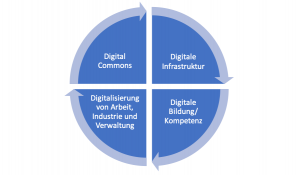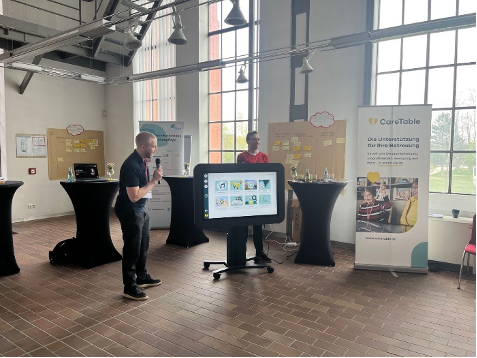Digitalisation in the changing state-country interrelations
Town and country are often seen as opposites. City life is generally associated with ideas of social density, economic dynamism and social innovation. While rural areas on the one hand evoke romantic ideas of peace, deceleration and traditionality, on the other hand they are often perceived as structurally weak, outdated and backward. In reality, the living environments of people in town and country are intertwined and spaces are connected in many ways. However, demographic change and increasing urbanization have contributed to an increasing discrepancy in development and participation opportunities between town and country in recent decades. Access to resources, the availability of public infrastructure and opportunities for social participation are often unevenly distributed across regions. In order to address these development differences and to meet the requirement of equal living conditions in different spatial areas, new concepts must be developed to balance out various inequalities between town and country. For regions, this means that integrated development can only succeed if these inequalities and resulting injustices are addressed across the different spatial forms and common solutions are found.
The BMBF project ReGerecht – Regional justice: Integrative development of a fair balance of interests between the city, the urban area and rural areas examines the question of how integrated development between the city, the surrounding area and rural areas can succeed if it is based on justice, balance and cooperation. This covers various topics such as settlement development and the protection of open spaces, indirect changes in location qualities, broadband expansion and comprehensive digitalization efforts as well as the possible networking of energy production and energy consumption. The digitalization work package deals with the question of how digital transformation can promote a fair balance of interests between city and country.
Digitalization is more than technology and infrastructure
Digital technologies are the basis of our current civilisational revolution. Infrastructures that enable access to digital technology are the prerequisite for being able to take part in this revolution. However, digitalisation goes far beyond infrastructure and technology. The ubiquitous availability of information and knowledge and developments such as the Internet of Things (IoT), Smart Cities and their rural counterpart Smart Country open up completely new possibilities for solving many social challenges such as the restructuring of cities and industries, the energy transition, digital administration and new forms of mobility. They also enable new forms of social involvement and participation. However, digitalisation is also associated with fears and insecurities for many people. In particular, topics such as big data and data security, artificial intelligence, state surveillance or manipulation through social media trigger unease in many, which often turns into resistance to digitalisation processes in general. Digital skills are therefore just as important for opportunities for participation through digitalisation as access to broadband internet.
Fundamentally, four dimensions can be distinguished for digitalization processes, each of which contains its own questions of justice and participation (see Figure 1: Dimensions of digitalization):

Figure 1: Dimensions of digitalization
1. Digital Infrastructures
Participation requires high-quality, comprehensive infrastructure. This aspect primarily concerns the expansion of broadband internet and fast mobile networks (LTE) in previously underserved regions. The unequal access and slow expansion of these infrastructures also means that many regions will experience long-term competitive disadvantages as a place to live, work or do business. In addition to infrastructures that enable individual or official access to internet services, the infrastructures that are necessary for the energy transition for society as a whole and the expansion of networks for renewable energies are also important in this context, as these are also heavily dependent on the use of sensors and smart controls.
2. Digital legal and organizational framework
Digitalization requires coordination and networking of actors and legal instruments. The handling of data plays an important role here - especially open data and digital administration, data commons, data protection and security, smart technologies (especially IofT, automation and sensor technology), etc.
3. Digital Participation and Digital Commons
Digitalization creates new common goods and forms of community in which every individual must be able to participate. This area primarily affects education, health, mobility and cultural offerings, but also participation, civil society engagement and volunteering.
4. Digital skills
Digitalization requires many people to acquire new skills in order to benefit from the advantages and opportunities of an increasingly digitalized world of life and work and to be able to actively shape this social transformation. The acquisition of these skills must be made equally possible for all citizens, regardless of demographic characteristics such as age, gender, place of residence or origin.
Digitalization and balancing of interests between city and country
The opportunities for life, development and participation that are opened up by advancing digitalization are spatially very unevenly distributed in Germany. The separation still takes place primarily between cities and rural, so-called "structurally weak" regions, which poses major challenges for achieving the goal of "equality of living conditions" (Art. 72 (2)) for all citizens set out in the Basic Law. The design of digitalization processes is therefore closely linked to questions of spatial justice and spatially unequally distributed social participation opportunities. Existing divisions between growing and shrinking, economically prosperous and "left behind", aging and rejuvenating communities can be exacerbated by excluding these communities from the digital transformation. The study focuses on three subject areas: (1) public services, (2) efficiency of politics and administration and (3) the development opportunities of regions.
1. Digitalization can help improve local public services
Securing public services is still a problem for many rural communities in view of tight finances, increasing emigration and the aging of the rural population. Demographic change and increasing urbanization have contributed to an increasing discrepancy in living conditions between urban and rural areas in recent decades. There is also a clear need to catch up in the country when it comes to expanding digital infrastructure (especially broadband internet), which has been addressed since 2018 by the federal funding for broadband expansion is systematically addressed.
Rural, often structurally weak communities are disadvantaged in various areas such as mobility, culture, education, health and care, as well as local supply. With the expansion of fast internet connections, new technologies can reduce these inequalities, especially in public services. New mobility concepts, telemedicine and digital education offerings can offer new solutions to these disadvantages. Digitalization can strengthen rural areas in particular as places of innovation and be a testing ground for new technologies such as e-government, e-learning, smart technologies or open data in nature conservation and spatial planning. Digitalization can also help support voluntary work in public services, which is often the basis for local self-government, especially in rural communities. Through citizen (co-)administration, public goods and services are co-designed and supported by citizens. For example, they can help obtain information, e.g. as defect reporters, offer citizen advice and relieve authorities of the burden of, for example, preliminary application reviews, or be involved in the maintenance of public infrastructure and thus organize, for example, citizen buses or care transport.
2. Digitalization can improve the efficiency of politics and administration
Scarce financial and human resources in the public administration of rural communities put small communities at a disadvantage, for example when applying for funding programs or developing long-term development strategies. Digitization can relieve the burden on small communities in particular if resources and skills can be pooled through shared infrastructure. A networked administration serves to promote inter-municipal exchange and regional cooperation, which can also promote transparency and active citizen participation. The prerequisites for this are open architectures and standards that enable infrastructures to be used via common interfaces and open data. However, open government also requires a "cultural change" in administration and must be accompanied by organizational development towards greater transparency and openness of administration and politics towards citizens, civil society organizations and companies. However, this change also requires the promotion of digital competence in administration and the population.
3. Digitalization can be a development engine for rural regions
Access to digital infrastructure is a decisive location factor for many citizens and companies when deciding to settle in certain regions. The long overdue expansion of broadband networks in rural areas is now eliminating a fundamental infrastructure disadvantage for rural communities, opening up new development opportunities for many regions. Digital presences increase the visibility of rural communities and strengthen joint location policy. This visibility not only makes rural regions more attractive to tourists, it also encourages the "new desire for the countryside" of young families who can imagine life in the countryside beyond suburbanization, as well as the influx of "young old people" beyond retirement, for whom growing old in the countryside is becoming more attractive.
Digital transformation creates a stronger link between town and country and enables new living, working and business models. Access to broadband infrastructure is not only a prerequisite for the establishment of IT and digital economy companies in rural areas, it also attracts freelancers from the creative industries to the countryside and offers space for new business models, such as maker spaces and producer communities, or the digitally supported development of the regional circular economy, which links town and country more closely, e.g. in the production and marketing of regional food, products and services.
Digitalization is also changing the way many people live and work. For commuters, the "working in the city and living in the country" model was often associated with long journeys and dependence on the car in the past. However, access to the Internet is making living and working in many sectors increasingly location-independent and more flexible. Teleworking or mobile working, home offices and co-working spaces enable people in rural areas to separate their home and work without incurring major disadvantages in their everyday lives. Conversely, more and more city dwellers have second homes in the country that go beyond purely leisure use. Although home ownership is still the predominant standard in rural areas, it is conceivable that in the future, an offer of more rental apartments in rural communities could lead to greater population dynamics in different age groups.
Conclusion
Digitalization, as a socially designed process, must be adapted to the specific circumstances, characteristics and needs of certain communities in order to have a positive effect on local actors. Digitalization strategies must be based on the reality of life in communities and regions and involve local actors in decisions in order to contribute to the sustainable improvement of development and life opportunities locally. The prerequisites for the success of this regional integration are long-term urban-rural partnerships and long-term inter-municipal cooperation and the joint development of regional (including digital) strategies that translate social and technological innovations into local contexts.
If digitalization is supported and co-designed by a wide range of actors, it is not an end in itself, but a means of achieving specific goals and life plans. With political support and social support, digitalization can open up new opportunities to defuse or even eliminate existing inequalities and associated injustices between cities, surrounding areas and rural communities.
If you have any questions about the content of this blog post “Digitalization in the changing state-country interrelations”, the author Sabine Barthold will be happy to help you at sabine.barthold@tu-dresden.de or +49 (0)351 46337918.






